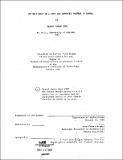| dc.description.abstract | The concept of self-help in a site and services project is based on the assumption that given the security of land tenureship_, an owner-builder can manage the whole process of house implementation. Generally, in any sponsored site and services project this assumption is supported by "aid" ; that is, the sponsor provides some financial and/or technical assistance. while this "aid" is minimum, often provided in the form of infrastructure, serviced plots, and some cash for purchasing building materials, it is assumed that such "aid" would assist the owner-builder in implementing the dwelling on the serviced plot. It is also assumed that the planning and construction of the dwelling would be carried out throughout the dweller's own decision-making and self-help efforts. In theory, the concept is valid. It is also adopted in most of the site and services projects in East Africa. Self-help is assumed to contribute towards economic savings, mobilization of human resources, increase in community spirit and group participation and to achieve a host of other benefits. This study looks at one such site and services project in Nairobi, the capital of Kenya. Through several in-depth case histories of carefully selected allottee families from the Dandora Community Development Project, a site and services project in Nairobi, the thesis shows the actual form(s) and practice of self-help. Several allottees were interviewed to understand further the real nature of self-help. That is, who did what, when, how and at what cost. Other inquiry was on the background and characteristics of the allottees' families, their approach to house planning and construction, characteristics and economics of construction, self - help practice amongst different: groups of allottees', cost and benefits of self-help and some impact of the rules of the Dandora Community Development Department (DCDD) in house implementation. The study presents several case histories of immigrant families in the process of urbanization in Nairobi. The cases trace the path of these low-income families from squatter settlements to the site and services project, emphasizing the element of self-help underlying the process of settlement. The actual role of an owner-builder is different from some of the assumptions held on self-help housing. The hard line of economic cost and benefits, as perceived in theory, does not necessarily hold true and neither do other assumptions on self - help applications in the site and services project. Chapters 1 and 2 present some background to the study, the research method employed and some of the theoretical constructs underlying the concept of self-help. In Chapters 3, 4, 5, 6 and 7 findings of the field research are presented. Specifically, different forms of self-help, their characteristics, practice, costs and benefits, and some illustrations as observed in the site and services project are presented. All the material covered under these Chapters is an outcome of the author's intensive field research on the allottees of the Dandora Community Development Project, from later 1978 to mid 1979. In· Chapter 8 the uses, costs, and benefits of the dwellings completed by means of the various self-help forms are further articulated. In the final Chapter the findings on actual self-help practices are compared with the held on self-help. This analysis is followed by major conclusions drawn from the study. | en_US |
